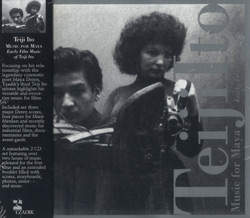
Teiji Ito was born in Japan in 1935 but moved to the United States at age six. Preternaturally talented, he was composing for Maya Deren's films by the age of seventeen ("The Very Eye of Night", included here) and continued to do so through her death in 1961. As represented on this two-disc set, the range of genres he traveled is nothing short of astonishing, though there's little sense of dilettantism at play; he may not penetrate too deeply into a given area but one has the idea that he was quite serious about his investigations. One might even think of him as a kind of proto-John Zorn. Disc One is given over to music created specifically for Deren's films as director or writer from 1952 to 1961 as well as three sections commissioned by the United Nations while Disc Two encompasses soundtrack for other related directors from 1956 to 1967.
The UN pieces are something of travelogues intended to illustrate the musical traditions of three or four areas in Asia: India, Java/Korea (an odd juxtaposition) and China. They're kind of na�ve in one respect, taking sonic elements from each culture and compressing native forms into bite-size pieces, but they're entirely charming and reasonably evocative of the music they seek to portray, serving their purpose as, perhaps, an introduction to the areas for otherwise innocent listeners, The soundtrack to "Meshes of the Afternoon" (1959) combines an acoustic guitar played in koto-fashion (though with hints of flamenco which will resurface later) with a shakuhachi-esque flute and percussion before expanding further into voice, cello and more. It's a fascinating work, spare and thoughtful, avoiding any tinge of "exotica", referencing kabuki to a great extent. "The Very Eye of Night", the piece written when Ito was 17, is remarkably mature; one might mistake it for something by Lou Harrison from around the same time, replete as it is with gamelan allusions, though accompanied by a somber clarinet and soon, a small wind ensemble (all instruments played and overdubbed by Ito) whose thematic material has something in common, inadvertently no doubt, to Mingus' forays into neoclassical composition such as "Adagio Ma Non Troppo". The three sections of "Maeva" (1961), for the film about a Tahitian native written by Deren but directed by Umberto Bonsignori, unsurprisingly utilize a good deal of percussion with a South Pacific feel, colored with flute and clarinet, the rhythms generating something of a Harry Partch effect. All of these pieces are effective and occasionally stunning in their artless but loving relocation of Eastern tropes into a Western art context.
The second disc contains music that's almost absurdly wide-ranging, often within the same piece, giving rise to the Zorn comparison made above. His cut and paste aesthetic of the 1980s, largely via Carl Stalling, appears strongly anticipated here. From the homemade gamelan with soft scat of "Dwightiana" (very Don Cherry-like!) to the "classical" guitar with perverse clarinet of "Bagatelle for Willard Maas"; from the lovely hammered dulcimer (presaging Laraaji) of "Moonplay" to the loopy electronics and percussion of :Operation Hourglass"; from the steel drums of "Water Music Study" to the screeching free jazz of "Orgia" and "Work of Matisse" and finally to the lush, earthy percussive garden "Lifelines" for Ed Emshwiller's film.
Comments and Feedback:
|



